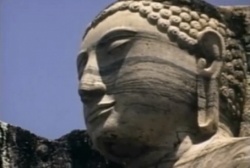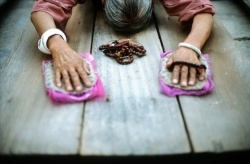Difference between revisions of "NanjoTokimitsu"
| Line 8: | Line 8: | ||
[[Tokimitsu]] was an {{Wiki|infant}} when his father met [[Nichiren]] and became a follower of his [[teaching]]. Upon the elder [[Nanjo's]] [[death]], [[Nichiren]] traveled from [[Wikipedia:Kamakura, Kanagawa|Kamakura]] to Ueno Village to offer [[prayers]] for his [[repose]]. It was then, at age seven, that [[Tokimitsu]] is said to have first met [[Nichiren]]. In 1274, immediately after [[Nichiren]] took up residence at [[Minobu]], [[Tokimitsu]] went to see him again. This encounter seems to have deepened his [[faith]] in [[Nichiren's]] teachings. In 1275 [[Nikko]], | [[Tokimitsu]] was an {{Wiki|infant}} when his father met [[Nichiren]] and became a follower of his [[teaching]]. Upon the elder [[Nanjo's]] [[death]], [[Nichiren]] traveled from [[Wikipedia:Kamakura, Kanagawa|Kamakura]] to Ueno Village to offer [[prayers]] for his [[repose]]. It was then, at age seven, that [[Tokimitsu]] is said to have first met [[Nichiren]]. In 1274, immediately after [[Nichiren]] took up residence at [[Minobu]], [[Tokimitsu]] went to see him again. This encounter seems to have deepened his [[faith]] in [[Nichiren's]] teachings. In 1275 [[Nikko]], | ||
| − | later [[Nichiren's]] designated successor, visited the grave of the late [[NanjoHyoe | + | later [[Nichiren's]] designated successor, visited the grave of the late [[NanjoHyoe Shichiro]] on [[Nichiren's]] behalf; from that [[time]] on, [[Tokimitsu]] looked up to [[Nikko]] as his [[teacher]] in the practice of [[Nichiren's]] teachings and aided him in {{Wiki|propagating}} them. [[Propagation]] proceeded energetically, especially in the Ueno and [[Atsuhara]] areas, and many [[people]] converted. [[Tokimitsu]] [[offered]] his residence for use as a center of [[propagation]] [[activities]]. As the number of converts, which included local {{Wiki|priests}} and {{Wiki|farmers}}, increased under [[Nikko's]] [[leadership]], official and private opposition increased. During what came to be known as the [[Atsuhara Persecution]], [[Tokimitsu]] used his influence to {{Wiki|protect}} other believers, sheltering some in his home. |
[[Nichiren]] honored him for his [[courage]] and tireless efforts by calling him "[[Ueno the Worthy]]," though he was only about twenty at the [[time]]. In retaliation for [[Tokimitsu's]] support of [[Nichiren]] and his followers, the {{Wiki|shogunate}} levied exorbitant taxes upon him. Official pressure continued for several years, and the [[Nanjo]] family was forced to live in extreme {{Wiki|poverty}}. Even under these circumstances, and while struggling to raise their nine sons and four daughters, [[Tokimitsu]] and his wife, [[Otozuru]] (also known as [[Myoren]]), consistently made [[offerings]] to [[Nichiren]]. | [[Nichiren]] honored him for his [[courage]] and tireless efforts by calling him "[[Ueno the Worthy]]," though he was only about twenty at the [[time]]. In retaliation for [[Tokimitsu's]] support of [[Nichiren]] and his followers, the {{Wiki|shogunate}} levied exorbitant taxes upon him. Official pressure continued for several years, and the [[Nanjo]] family was forced to live in extreme {{Wiki|poverty}}. Even under these circumstances, and while struggling to raise their nine sons and four daughters, [[Tokimitsu]] and his wife, [[Otozuru]] (also known as [[Myoren]]), consistently made [[offerings]] to [[Nichiren]]. | ||
Latest revision as of 02:17, 18 April 2014
Nanjo Tokimitsu
南条時光 (1259–1332)
Also known as Ueno, because he lived in Ueno Village in Fuji District of Suruga Province, Japan, and became the steward of that village. A lay follower of Nichiren and the second son of NanjoHyoe Shichiro. His full name was NanjoShichiroJiroTaira no Tokimitsu. He began practicing Nichiren's teachings quite early in life. In 1265 his father, an official of the Kamakura shogunate, died, and he lost his eldest brother, ShichiroTaro, in 1274. This forced Tokimitsu to assume the duties of the steward of Ueno while still in his teens.
Tokimitsu was an infant when his father met Nichiren and became a follower of his teaching. Upon the elder Nanjo's death, Nichiren traveled from Kamakura to Ueno Village to offer prayers for his repose. It was then, at age seven, that Tokimitsu is said to have first met Nichiren. In 1274, immediately after Nichiren took up residence at Minobu, Tokimitsu went to see him again. This encounter seems to have deepened his faith in Nichiren's teachings. In 1275 Nikko,
later Nichiren's designated successor, visited the grave of the late NanjoHyoe Shichiro on Nichiren's behalf; from that time on, Tokimitsu looked up to Nikko as his teacher in the practice of Nichiren's teachings and aided him in propagating them. Propagation proceeded energetically, especially in the Ueno and Atsuhara areas, and many people converted. Tokimitsu offered his residence for use as a center of propagation activities. As the number of converts, which included local priests and farmers, increased under Nikko's leadership, official and private opposition increased. During what came to be known as the Atsuhara Persecution, Tokimitsu used his influence to protect other believers, sheltering some in his home.
Nichiren honored him for his courage and tireless efforts by calling him "Ueno the Worthy," though he was only about twenty at the time. In retaliation for Tokimitsu's support of Nichiren and his followers, the shogunate levied exorbitant taxes upon him. Official pressure continued for several years, and the Nanjo family was forced to live in extreme poverty. Even under these circumstances, and while struggling to raise their nine sons and four daughters, Tokimitsu and his wife, Otozuru (also known as Myoren), consistently made offerings to Nichiren.
When Nichiren died on the thirteenth day of the tenth month, 1282, Tokimitsu attended the funeral ceremony along with such longtime followers as ShijoKingo, Toki Jonin, the Ikegami brothers, and Ota Jomyo. In 1289 Nikkoleft Minobu and went to live at Tokimitsu's residence in Ueno Village at the latter's invitation. Tokimitsu donated to him the tract of land called Oishigahara, on which a temple called Dai-bo was completed on the twelfth day of the tenth month, 1290. This was the origin of Taiseki-ji temple. In his later years, Tokimitsu became a lay priest and assumed the name Daigyo(Great Practice). On the thirteenth day of the eighth month, 1323, his wife died. In the third month of the following year, Tokimitsu built Myoren-ji temple in her honor, naming it after her Buddhist name Myoren (Wonderful Lotus); it is thought that this temple had formerly been Tokimitsu's residence. Tokimitsu died on the first day of the fifth month, 1332. Nichiren's extant letters to Tokimitsu number more than thirty, the largest number among those addressed to any of his followers.

